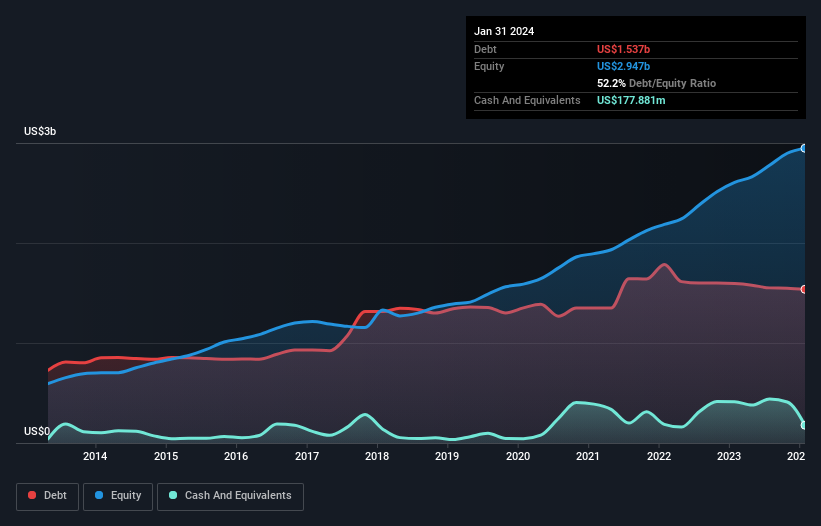- United States
- /
- Food and Staples Retail
- /
- NasdaqGS:CASY
Here's Why Casey's General Stores (NASDAQ:CASY) Can Manage Its Debt Responsibly

The external fund manager backed by Berkshire Hathaway's Charlie Munger, Li Lu, makes no bones about it when he says 'The biggest investment risk is not the volatility of prices, but whether you will suffer a permanent loss of capital.' So it might be obvious that you need to consider debt, when you think about how risky any given stock is, because too much debt can sink a company. We can see that Casey's General Stores, Inc. (NASDAQ:CASY) does use debt in its business. But the more important question is: how much risk is that debt creating?
When Is Debt Dangerous?
Generally speaking, debt only becomes a real problem when a company can't easily pay it off, either by raising capital or with its own cash flow. Ultimately, if the company can't fulfill its legal obligations to repay debt, shareholders could walk away with nothing. However, a more usual (but still expensive) situation is where a company must dilute shareholders at a cheap share price simply to get debt under control. Of course, the upside of debt is that it often represents cheap capital, especially when it replaces dilution in a company with the ability to reinvest at high rates of return. When we examine debt levels, we first consider both cash and debt levels, together.
Check out our latest analysis for Casey's General Stores
What Is Casey's General Stores's Net Debt?
The chart below, which you can click on for greater detail, shows that Casey's General Stores had US$1.54b in debt in January 2024; about the same as the year before. However, because it has a cash reserve of US$177.9m, its net debt is less, at about US$1.36b.

How Healthy Is Casey's General Stores' Balance Sheet?
We can see from the most recent balance sheet that Casey's General Stores had liabilities of US$880.9m falling due within a year, and liabilities of US$2.38b due beyond that. On the other hand, it had cash of US$177.9m and US$158.5m worth of receivables due within a year. So its liabilities total US$2.92b more than the combination of its cash and short-term receivables.
This deficit isn't so bad because Casey's General Stores is worth a massive US$11.7b, and thus could probably raise enough capital to shore up its balance sheet, if the need arose. But it's clear that we should definitely closely examine whether it can manage its debt without dilution.
We measure a company's debt load relative to its earnings power by looking at its net debt divided by its earnings before interest, tax, depreciation, and amortization (EBITDA) and by calculating how easily its earnings before interest and tax (EBIT) cover its interest expense (interest cover). The advantage of this approach is that we take into account both the absolute quantum of debt (with net debt to EBITDA) and the actual interest expenses associated with that debt (with its interest cover ratio).
Casey's General Stores's net debt is only 1.3 times its EBITDA. And its EBIT covers its interest expense a whopping 13.2 times over. So we're pretty relaxed about its super-conservative use of debt. Fortunately, Casey's General Stores grew its EBIT by 7.5% in the last year, making that debt load look even more manageable. When analysing debt levels, the balance sheet is the obvious place to start. But it is future earnings, more than anything, that will determine Casey's General Stores's ability to maintain a healthy balance sheet going forward. So if you're focused on the future you can check out this free report showing analyst profit forecasts.
But our final consideration is also important, because a company cannot pay debt with paper profits; it needs cold hard cash. So we clearly need to look at whether that EBIT is leading to corresponding free cash flow. Over the most recent three years, Casey's General Stores recorded free cash flow worth 62% of its EBIT, which is around normal, given free cash flow excludes interest and tax. This cold hard cash means it can reduce its debt when it wants to.
Our View
Happily, Casey's General Stores's impressive interest cover implies it has the upper hand on its debt. And its conversion of EBIT to free cash flow is good too. When we consider the range of factors above, it looks like Casey's General Stores is pretty sensible with its use of debt. That means they are taking on a bit more risk, in the hope of boosting shareholder returns. The balance sheet is clearly the area to focus on when you are analysing debt. But ultimately, every company can contain risks that exist outside of the balance sheet. For example - Casey's General Stores has 1 warning sign we think you should be aware of.
At the end of the day, it's often better to focus on companies that are free from net debt. You can access our special list of such companies (all with a track record of profit growth). It's free.
New: AI Stock Screener & Alerts
Our new AI Stock Screener scans the market every day to uncover opportunities.
• Dividend Powerhouses (3%+ Yield)
• Undervalued Small Caps with Insider Buying
• High growth Tech and AI Companies
Or build your own from over 50 metrics.
Have feedback on this article? Concerned about the content? Get in touch with us directly. Alternatively, email editorial-team (at) simplywallst.com.
This article by Simply Wall St is general in nature. We provide commentary based on historical data and analyst forecasts only using an unbiased methodology and our articles are not intended to be financial advice. It does not constitute a recommendation to buy or sell any stock, and does not take account of your objectives, or your financial situation. We aim to bring you long-term focused analysis driven by fundamental data. Note that our analysis may not factor in the latest price-sensitive company announcements or qualitative material. Simply Wall St has no position in any stocks mentioned.
About NasdaqGS:CASY
Casey's General Stores
Operates convenience stores under the Casey's and Casey’s General Store names.
Acceptable track record with mediocre balance sheet.
Similar Companies
Market Insights
Community Narratives



